Fairy Tales & Fables Part 1: Little Red Riding Hood, The Three Billy Goats Gruff, & The Three Little Pigs
There are so many reasons for parents to read fairy tales and fables to young
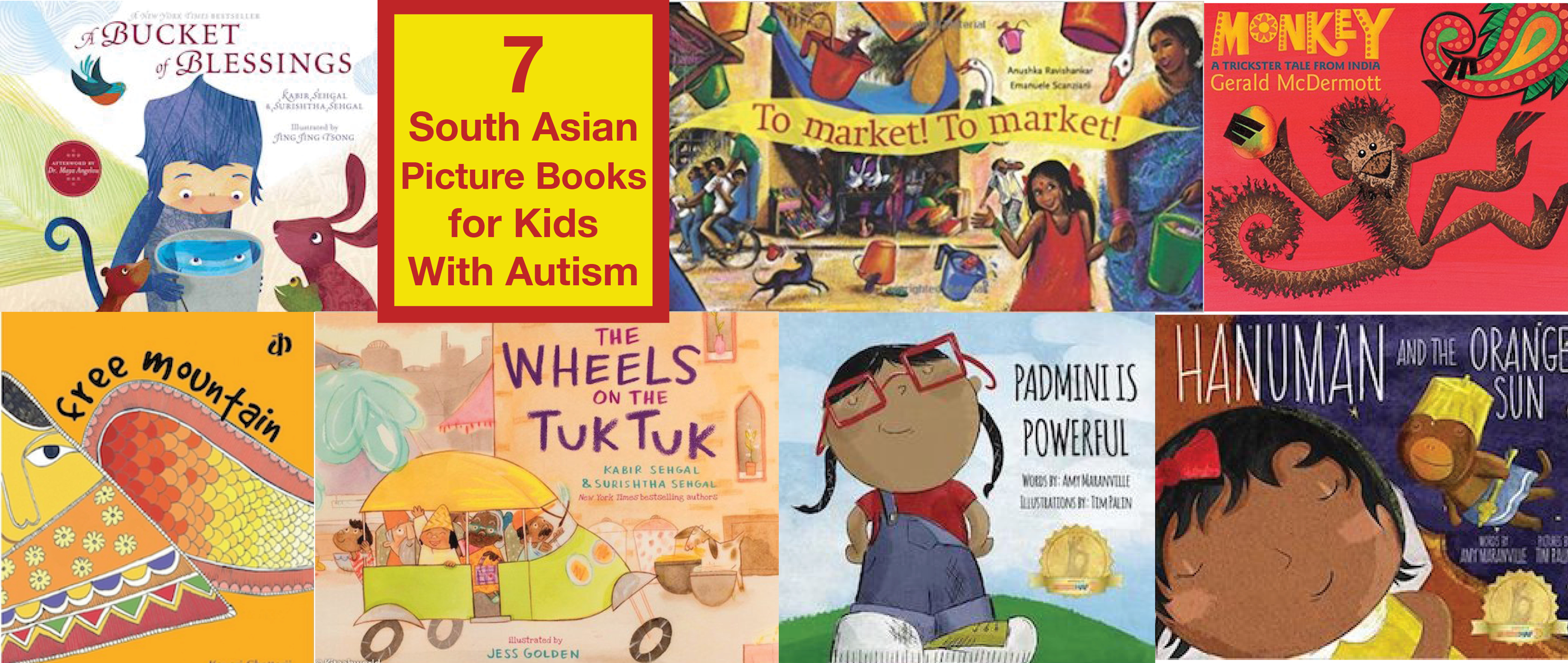
Happy World Autism Awareness Day! I am pleased to be cross-posting today with the South Asian and diverse independent children’s online bookseller KitaabWorld.
For my collaboration with KitaabWorld, we combed through their catalog with autism and preschoolers in mind and came up with a shortlist of books that I spent a few months testing out (and for full disclosure, I received a discount on the books I bought). Since KitaabWorld's readers might not be as familiar as my readers with the kind of criteria one uses to choose books for kids with autism, I also wrote an introductory post ("Picking Picture Books for Kids with Autism") describing what I am looking for in a picture book for a child on the spectrum.
My sons and I had a great time testing the books KitaabWorld recommended. Here are the 7 that worked the best!
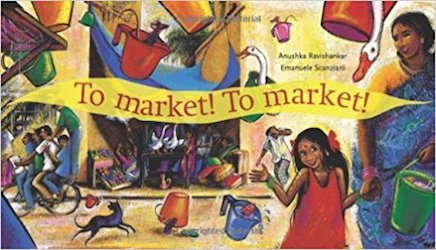
By Anushka Ravishankar, Illustrations by Emanuele Scanziani
Tara Books, 2007; paperback, $8.95 USD

My son Harry loves To market! To market! A girl explores a busy Indian marketplace looking for something to buy with her spending money. The text has a bouncy rhythm and an easy rhyme scheme that is fun to read and keeps kids anchored in the story.
As an object, the book itself is an unusual shape; it’s a landscape-oriented rectangle, and the pages fold upwards. It’s really easy for little hands to hold, and the unusual page action adds interest.
I love a strong circular plot, like this one, because it makes kids feel confident when they can predict what’s coming. As the girl explores different sections of the marketplace she sees different wares for sale: bangles, garlands (“posies”), roosters, fabric, fruit, fish and seafood, chili peppers and spices, and a stand selling masks and mirrors. A word related to the goods represented on each page repeats in an artful way as a kind of visual onomatopoeia.
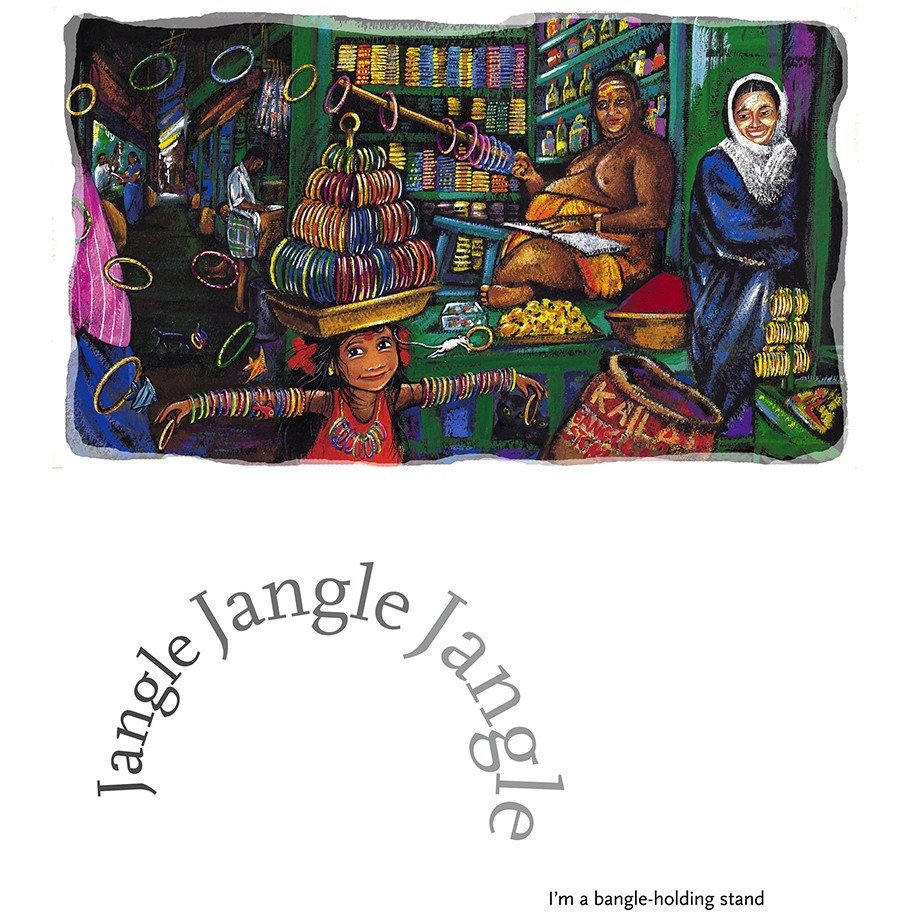
The book has built-in sensory opportunities too. The beat gets you moving, and then each spread has something more to imitate. My son does some gross motor imitation on each page—he pretends (as the girl does) to be a bangle stand, “smells” the posies, runs “faster faster faster” like the rooster, makes funny faces in the mirror like the girl, and more.
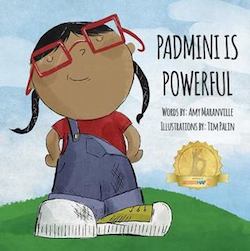
By Amy Maranville, Illustrations by Tim Palin
Mascot Books, 2015; board book, $9.95 USD

This is a fun twist on the usual color primer, animal primer, vehicle primer snoozefest—a Gods primer!
I must warn that there are some big challenges here for children with even milder forms of autism. Of all the books I chose to review and recommend—and I do recommend this book—Padmini is Powerful was hands-down the most challenging, which was interesting since it was the only board book in the mix.
Each two-page spread introduces a different god and has one simple sentence showing that Padmini (our child character) shares a powerful attribute with that god.
But even though the words are sparse, that one single sentence introduces two very tricky demands on a child: the name of the god (likely unfamiliar) and an abstract attribute that makes that god powerful. What I mean by “abstract” is that it’s not that Ganesh is big or has an elephant’s head that is mentioned—it’s that he’s "wise.” The list of attributes the book uses are: “wise,” “creative,” “full of energy,” “generous and kind,” “can focus,” “creates,” and “can protect what she creates.”
The attributes are depicted in the illustrations, but subtly. For “wise,” Padmini holds a toothbrush (She’s smart about dental hygiene!) and Ganesh is meditating. Some of the pages do a better job. The spread for “generous and kind” is more clear: Padmini shares a milkshake with a chipmunk while the Goddess Lakshimi shares coins with the reader.
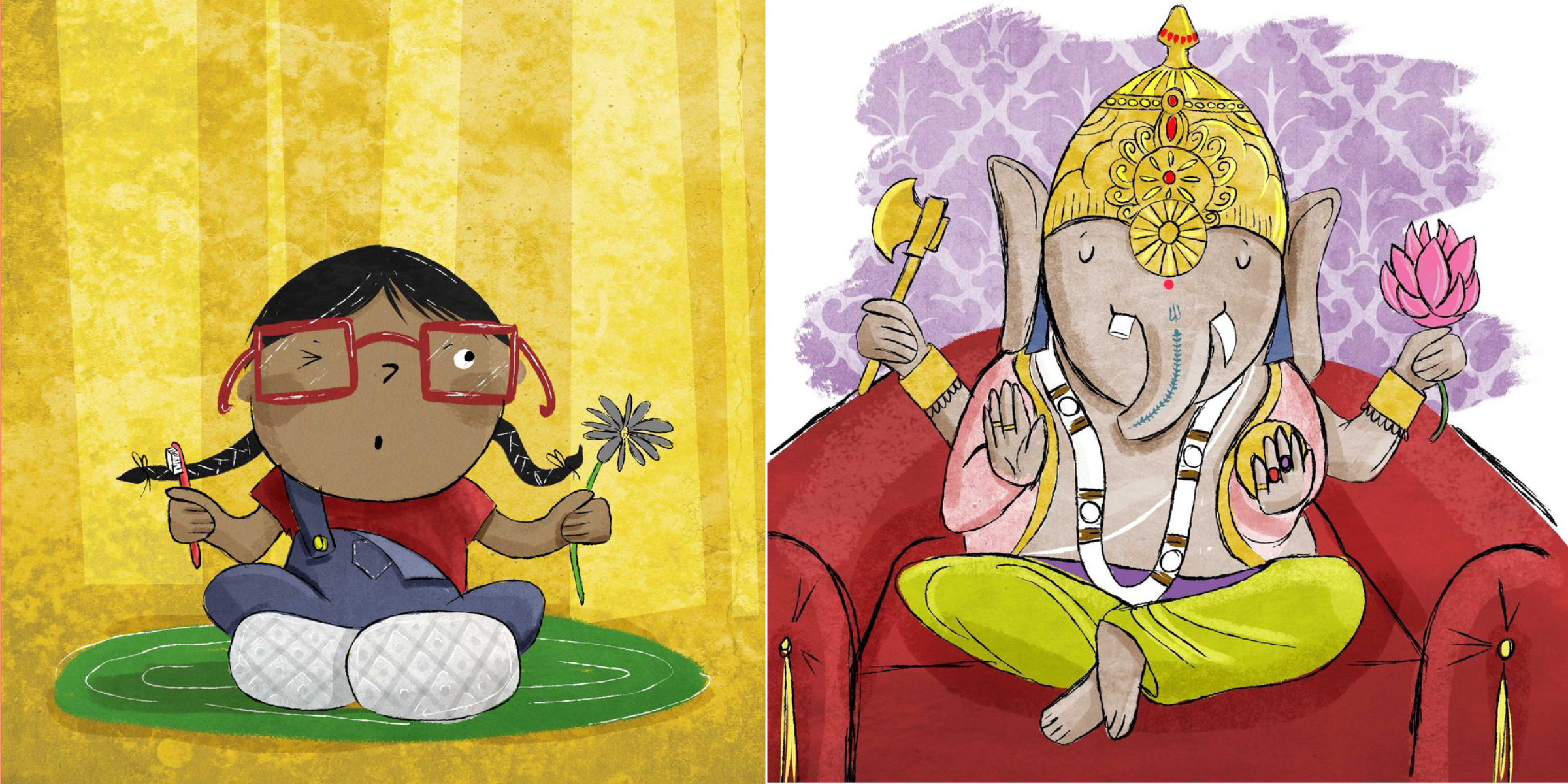
Despite these challenges, the brightly drawn Hindu gods are interesting to children in and of themselves, and that exposure is great. It’s fun to tact (label) the many different objects the gods are holding, and my sons are greatly amused to count how many arms and heads each god has. This kept their interest up from page to page. I’m also pleased to have a little girl depicted as “powerful” in a book they read.
Last but not least, there is a good sensory addition. The last page of the board book has a small mirror to bring the reader into the book.
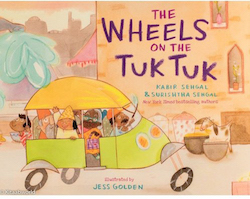
by Kabir Sehgal & Surishtha Sehgal; Jess Golden (Illustrator)
Beach Lane Books (2016); hardcover, $17.99 USD

I reviewed this book only a few months ago (10 Books to Introduce Race & Ethnicity to Kids with Autism), but I had to include it on this list too. It’s that special.
The Wheels on the Tuk Tuk brilliantly centers an exploration of an Indian town around the familiar nursery song, “The Wheels on the Bus,” instantly communicating with "Tuk Tuk wheels go round and round" that the tuk tuk is equivalent to a city bus. This basis for comparison is cemented a few pages later when the "Rupees on the bus go ching ching ching."
There are moments that don’t have a "Wheels on the Bus" equivalent, but that adds to the fun. It's impossible not to laugh when a cow sits down in front of the tuk tuk ("Tuk tuk stops for moo-moo-cow.") or when the "Elephant's trunk goes spray-spray-spray" (which of course leads to the wipers going swish swish swish!). As with all familiar song patterns, this book makes great practice for intraverbals (aka “fill-ins”) and really encourages a child’s attention and participation.
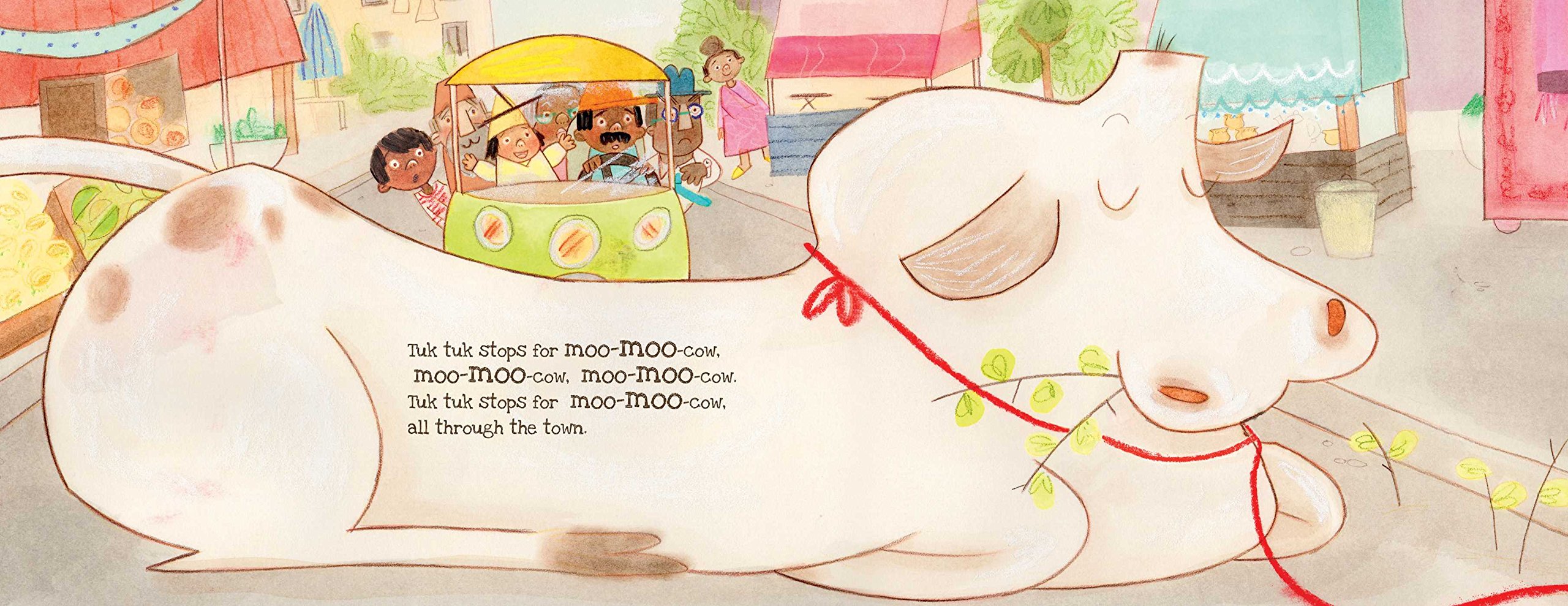
My son Luke absolutely adores The Wheels on the Tuk Tuk and loves to try to sing along. I love watching him take in this very different landscape of small town India. It's clear to me he's studying it carefully.
Variations on well-loved themes are very good for kids like Luke, who is on the moderate-to-severe end of the spectrum, as they help expand their world in a way that is scaffolded by the familiar and safe. Songs are great for kids with attention issues because they add a consistent sensory component (listening to music, singing), and this increases interest.
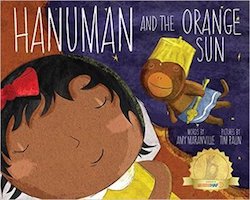
By Amy Maranville, Illustrations by Tim Palin
Bharat Babies (2015); hardcover, $19.95

The author’s note explains that Hanuman and the Orange Sun is based on ancient Hindu lore. Hanuman, a monkey and baby god, mistakes the sun for a giant orange and eats it—plunging the world into darkness.
In this picture book retelling, we have a story within a story. The legend of Hanuman is told to a little girl, Hairini, by her mother. And the moral of the story—that you must be careful how you use your strength—is explicitly discussed at the end by the two of them.
The trickiest parts of the book for my kids are definitely the beginning and ending pages with Hairini and her mother. There just isn’t much action and the text is fairly dense prose. I skip over this quickly by ad-libbing the necessary information and running through the dialogue using my best mom and Hairini voices. But I do linger a bit on one illustrative detail: the mom wears a red bindi on her forehead. It’s good to see a clear and relatable representation of a religious Hindu woman in a picture book.
I watched my son Harry touch his finger to the center of his forehead while looking at her; he clearly has noticed it, and while other books I reviewed showed religious women as well, this was the book where it grabbed his attention. For me, giving my white Jewish sons exposure is a big part of the exercise. For a family that shares this cultural background, it’s another good opportunity to see their culture reflected back in a book.
Once Hanuman (the baby monkey god) arrives there is lots of non-stop action, and the density of the words matters far less. But because humor relating to function of objects is something that my kids are still working on, I step out of the story to make sure the point is clear: The monkey thinks the sun is a big orange! That’s not an orange; that’s the sun! Can you eat the sun? No! Silly monkey, you don’t eat the sun! You use the sun to get warm/for light. Etc.
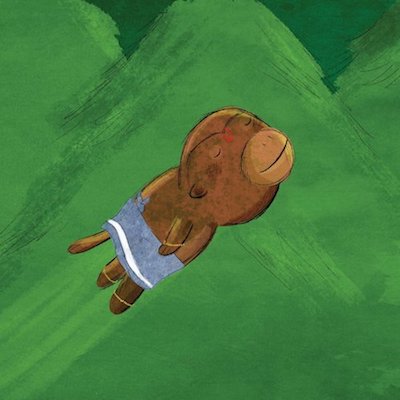
We get great gross motor imitation opportunities as the monkey flies higher and higher, and then there is the payoff: “CHOMP!” when Hanuman eats the sun. I emphasize how scared Hanuman is when everything goes dark by acting out “scared” and getting my kids to show me what scared looks like in imitation.
This is a good opportunity to practice that emotion. After Hanuman gets help from the gods and opens his mouth to let the sun out, the image (in my opinion) calls for a dramatic belch—but I can’t quite bring myself to do it… My son Luke loves it when Hanuman falls back to earth (“Thud!”) at the end.
Hanuman and the Orange Sun is a riot. It’s great for kids who like physical comedy, in particular, and it is very good practice for dialoging about the function of objects using sun and orange as examples.
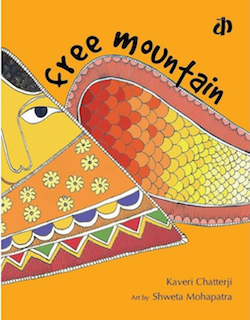
By Kaveri Chatterji, Illustrations by Shweta Mohapatra
Katha World Library (2010); paperback, $4.95

Once upon a time, mountains had wings and flew! But then some mean kings chopped of their wings and they cried (wouldn’t you?) and the mountains couldn’t move. But one mountain dreams of being free again, and incredibly the book does not end with her flying away, but rather feeling free because she has so many (animal) friends.
The text rhymes, although (I suspect owing to translation) the rhythm feels off occasionally. It’s amazing how movement-filled the book feels considering it is about a mountain who can’t move! The illustrations pop against a white background with colors that contrast in interesting ways.
As the mountain’s animal friends are introduced, a year passes, and the months of the year are named. The animals also appear in numbered groups that increase by a factor of one as we go (one whale, two rhinos, three dolphins, etc.). So in “January she meets one wise whale with a smile so wide,” and so on. What is a bit odd is that, presumably because the author only wanted to go up to ten, we get “March, April she spies…” for the three dolphins, and “May, June she eyes…” for the four elephants.
While it’s always good to get extra practice at hearing the months of the year in order, this grouping of four of the months into twos is a bit confusing. And there’s really nothing in the pages that helps visually convey passage of time (especially a year of time) or seasonality. That part is a miss for me.
On the other hand, both of my children love to tact (label) numbers and 1:1 correspondence counting is highly reinforcing. I like that the author and illustrator elected to include both an artistic representation of the numeral (i.e. “9”) and the written number word (“nine”). It’s good practice to see both along with a drawing of nine chameleons, etc.
File under: Great counting books for kids who love animals.
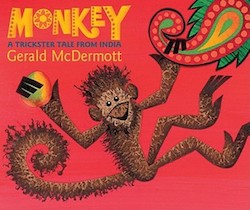
By Gerald McDermott
Harcourt Children’s Books (2011); hardcover, $16.99

The story of the clever monkey and the hungry crocodile is an ancient Buddhist folktale that was first translated from Sanskrit to English in the nineteenth century.
Monkey: A Trickster Tale from India immediately appealed to my son Harry, who loves animals and does really well with books that suggest a variety of gross motor imitation movements. He has a great time hopping from rock (pillow) to rock (pillow) like Monkey, pretending to swing from branches, throwing the mango (a stuffie, usually) in Crocodile’s mouth (my arms pretending to be Crocodile jaws) to trick him, and sometimes pretending to be Crocodile snapping his arms shut like he is trying to take a bite out of Monkey. I showed him how to do these things by modeling it first myself, and this quickly became a book that got his attention because he had all these active roles to play. He likes knowing what his job is.
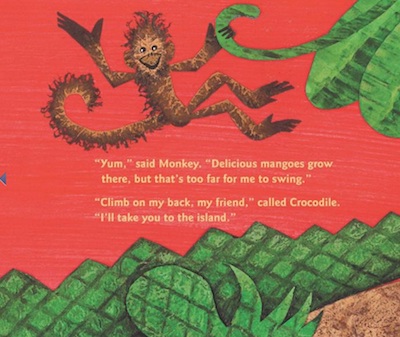
The book is a bit text heavy—far too text heavy for my son Luke—and I often shorten it for this reason. One very simple way to do this is to drop all the speaker attribution notes (“Monkey said” or “Crocodile said”) in favor of giving each character a distinct voice. I made the monkey high-pitched and silly and the crocodile deep-throated and serious to distinguish them. I also, however, clip unnecessary words and phrases as I go to keep things moving.
A personal peeve appears on the last page when Monkey says to Crocodile, “Your teeth may be sharp, but your mind is dull!” My son Luke doesn’t have the highest cognitive scores at the moment (that may change, but who knows) and I’m becoming very sensitive to the easy use of pejoratives about intelligence in media directed at children. This might seem overly sensitive, but I do feel strongly about it—so I always change this dialogue to “Your teeth may be sharp, but I tricked you!” which isn’t as figuratively neat, but does the job.
The best thing about this book is the art. Crocodile and Monkey are beautifully constructed using collages of cut and torn papers. The colors are bright and warm and contrasting. Best of all, the movements and emotions of the characters are well realized. It’s completely possible to tell this story just based on the pictures—and this is the mark of a very good narrative picture book for my kids, for whom language can be so challenging.
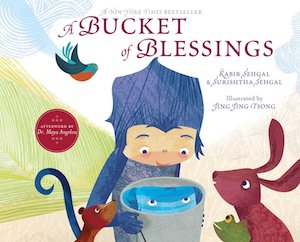
By Kabir Sehgal & Surishtha Sehgal; Illustrations by Jing Jing Tsong
Beach Lane Books (2014); hardcover, $16.99

In reading the author’s note for this book I discovered that peacocks are the national bird of India and that in the Hindu tradition a peacock often depicts Indra, the rain god. The dance of the peacock has long been associated with rain, and that’s what this book is about; the land is dry so Monkey journeys up the mountain with a bucket and a bit of water in the hopes that peacock can use it to make it rain by dancing.
There is just the right amount of prose on each page of this book for the attention spans of my twins, and the vocabulary is very carefully chosen and age-appropriate.
The book also has a particularly strong act two. On the second journey up the mountain, Monkey encounters three animals before reaching Peacock: Toad, Rabbit, and Mongoose. Their interactions are an example of circular plotting and use of repetition, and these are the pages where I can feel my kids’ attention is most focused on the book.
I particularly like that the approach the authors took here was to have each animal ask a question of Monkey that sequences the plot: 1. “Where did you find this wonderful water?” asked Toad. “Hidden inside a cave!” says Monkey; 2. “And where are you taking this wonderful water?” asks Rabbit. “Back up the mountain to Peacock!” says Monkey; and 3. “And what will you do with the wonderful water?” asks Mongoose. “We’ll try to make it rain!” says Monkey. (1) is what just happened, (2) is what is happening now, and (3) is what is next. Sequencing is such a difficult skill, and this is imbedded quite nicely. It’s truly wonderful practice.
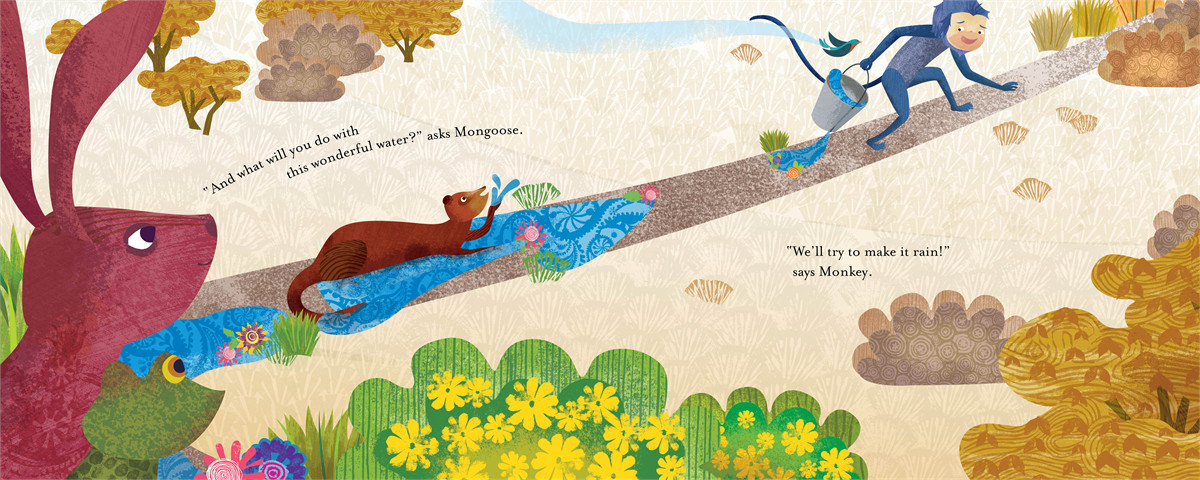
I also can’t say enough good things about the art. Tsong uses a layered lithograph/print technique that provides beautiful texture and dimensionality to the pictures. It’s a pleasure for adults and children.
While there isn’t a built-in sensory component it was easy enough to adapt it. Monkey pours the last few drops from his bucket on Peacock, so I splashed my kids’ heads with a bit of water from a cup. Then I cracked open my phone and pulled up a video of a peacock dancing on YouTube and showed it to them.
The peacock in the video puffs opens its feathers, shakes its butt, and slowly spins around, showing off. This was a lot of fun to imitate and made a great sensory break to look forward to while reading the story. To signify the rainy ending, I make huge thunder sounds and my kids and I make rain “fall” with our fingers.
This is a cross-post with the fabulous South Asian and diverse children's online bookseller KitaabWorld. I have not been paid to promote KitaabWorld or any of the books reviewed here.